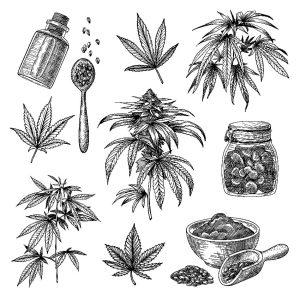The arrival of Cannabis in the UK

Cannabis is a plant based drug that can be eaten, smoked or vaped and is also known as Marijuana or weed. It is slightly questionable when cannabis first came to the UK, though there is evidence that seeds of the cannabis plant were found at an excavated Viking settlement in York dating back to the 10th century. However, it is generally recognised that it was introduced to the UK by an Irish doctor in 1842, one William Brooke O’Shaughnessy who had studied the drug when he was working in Bengal for the East India Company. However, it was not until the Dangerous Drugs Act of 1928 that the recreational use of cannabis was prohibited. Amazingly, strong pressure on Parliament came from the alcohol industry to make its use illegal and their reason was that they wanted to eliminate any competition in the intoxicant market. Doctors apparently lost interest in prescribing Cannabis as it became professionally and increasingly viewed as a dangerous drug rather than a beneficial medicine. Interestingly, it was not until 1952 that the first “cannabis bust” by the police took place. This was in London at the Number 11 Club in Soho.
Cannabis as a recreational drug
Cannabis use started to change from the 1960s. Many more young people started to experiment with it and the “hippy” culture evolved. It was openly and publicly used by music celebrities such as Bob Dylan, The Beatles and The Rolling Stones and it was almost given a seal of approval to try instead of or with alcohol. It became the cultural and anti-cultural drug of choice. Cannabis was seen as safe to use but there is clinical evidence that, even back then, it was a gateway drug for people who then moved on to using heroin as they became tolerant to its effects and were seeking something stronger.
Cannabis and increased THC content
The active component in Cannabis is THC which is shortened from delta-9-tetrahydrocannabinol. This produces the psychoactive effect of a mind altering drug. Back in the 60s and 70s the THC levels were modest by today’s standards: back then smoking a joint produced a mellow gradual high whereas today it can produce an instant mind bending trip. The reason for this is that prior to the 1990s THC levels were below 3 %, even within the higher strain known back then as Skunk. In the early 1990s the strength of THC grew to 4% but between 1995 and 2015 there was a huge jump to 14%. This increase is due the use of different farming methods which produce a more potent cannabis flower. It not uncommon to find cannabis with a THC strength of 20% in today’s illegal market. So currently, there are many strains of cannabis either being grown and farmed in the UK or being illegally smuggled that have a sole purpose of producing a high. The increased potency makes cannabis potentially more dangerous and more likely to result in drug addiction. It has also been linked with a measurably increased impact on mental health. The fact that people will not necessarily drink alcohol every day but will smoke cannabis daily is another factor in the rise of cannabis addiction.
Increased Cannabis supply
Studies showed that cannabis use in the UK and Worldwide had declined to a low in 1992 and then its use slowly rose again until 2008. Since then there has been a further rapid rise to its increased use today. There has also been a shift in availability with cannabis illegally imported into the UK from countries where its use has been legalised. This has resulted in a large ready supply to meet the increased new demand. For example, it is smuggled in from the Netherlands in containers, yachts and small boats as well as on light aircraft.
The UK has also recently seen a huge rise in the number of international airline passengers smuggling large quantities of cannabis in their luggage. The amount of the drug found and seized has tripled in under a year. In 2024 about 15 tons of Cannabis has so far been seized at UK airports compared with 5 tons throughout the whole of 2023 and only 2 tons in 2022. It has been established that couriers are being told that they will only be fined if caught with cannabis coming into the UK, as it is only a soft drug. The reality is that they are likely to be imprisoned when caught.
The UK has also seen a leap in the production of “home grown” or farmed cannabis: between 2004 and 2007, police detected around 800 cannabis farms per year that were classified as a commercial operation. This rose to 7000 farms started per year in 2009 and 2010. The greatest concentration of farms are in Manchester, West Yorkshire and the West Midlands. A total of 750,000 cannabis plants were found and destroyed by the police in 2009/10. Cultivation of cannabis plants is regarded as commercial if 25 or more plants are being cultivated in one place. Farms are often established in rented properties and commercial units but have become easier to locate using heat sensing equipment that picks up the high intensity lighting and the heat from the amount of electricity being used. Detection has led to the stabilisation of the amount of new farms being established. However there is now a far greater supply of cannabis from imports. This is feeding the increase in the number of people turning to cannabis and the increase in consumption by existing users. Long gone are the days of the 60s and 70s when if you wanted to buy cannabis it was “knowing someone who knew someone who might be able to get it”. Now, although it is an illegal drug, its availability is ubiquitous and there are movements to get it legalised.
Cannabis addiction and the threat it poses
The risk of a cannabis addiction is far greater in people who start using cannabis during their adolescence and in those who smoke cannabis more regularly and daily. The high THC levels which have been developed will affect the brain’s development as a brain continues to develop up to 25 years of age and cannabis impairs the brain’s development. There will be also an impairment of the rational thinking process coupled with distorted memory and learning functions. Cannabis can raise the heart rate for up to 3 hours after smoking and this can increase the chance of a heart attack. Anxiety and extreme forms of paranoia are regularly associated with daily cannabis use as is Cannabinoid Hyperemesis Syndrome which causes users to experience regular cycles of severe nausea, vomiting and dehydration.
The old adage that has long been associated with cannabis that it is a safe and soft drug is far from the truth. It has been developed and changed into a highly potent and now dangerous – a gateway to life-long drug addiction.
